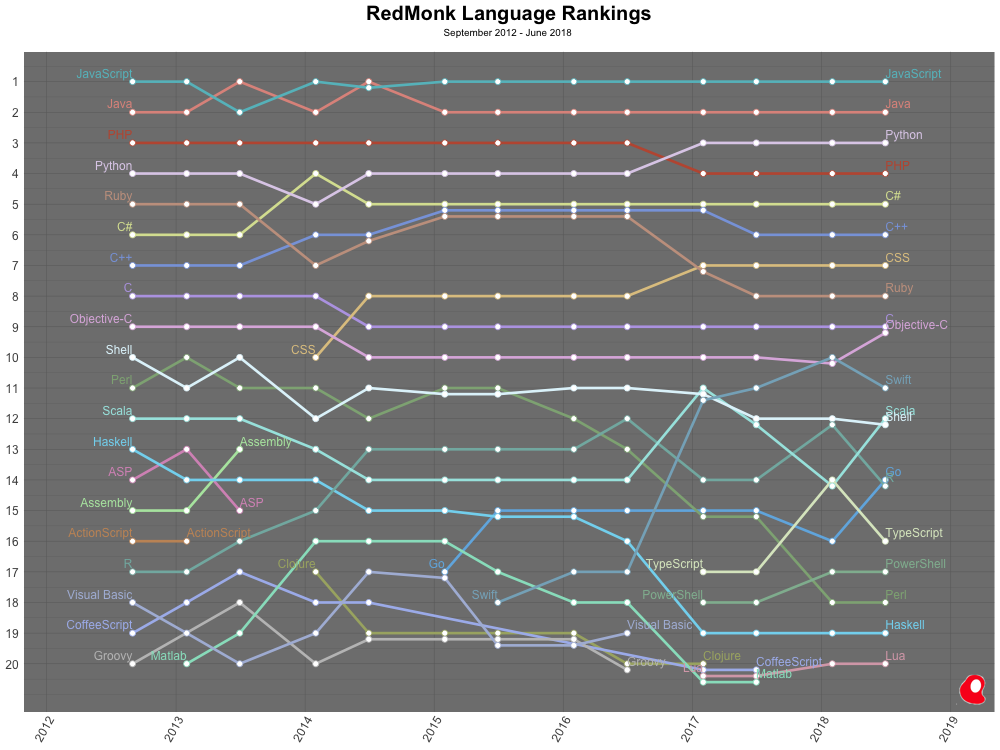
Older programming languages refuse to die. That’s the conclusion you could draw from analyst firm RedMonk’s latest visualization, which shows the popularity of various programming languages since September 2012. As you might expect, ultra-popular languages such as JavaScript, Python and Java have never lost momentum over the past six years; but even languages such as Objective-C, which Apple is actively attempting to sunset, have a way of clinging to life.  In mid-2012, Objective-C sat comfortably in ninth place in RedMonk’s popular-language rankings. Developers used the language to build macOS and iOS apps, and might have continued to do so for many years if Apple hadn’t rolled out Swift, which it positioned as Objective-C’s successor, in 2014. With every passing year, Swift becomes more sophisticated, and Apple’s dedication to it deeper. You’d think that would drive developers off Objective-C, and indeed, many of them have chosen to embrace Swift—but a sizable portion continue to work with the older language. It’s a similar (although not completely analogous) situation with R, a specialized language primarily used by data scientists. As Big Data and data analytics became more popular, so did R. Recently, however, other languages have become more useful in an analytics context, most notably Python, leading some pundits to suggest that R’s days are numbered. That’s not the case, according to RedMonk. Although R usage has certainly fallen from its peak, the language remains more popular than in 2012. Programming languages can quickly build a huge install base, especially if used across multiple platforms (i.e., mobile, IoT, Web, and so on). That makes languages generally hard to eradicate; code will persist in legacy apps and platforms for years, if not decades (Hi, federal government!). And that’s good news for tech pros: it means that any language-based skills you learn are unlikely to become devalued anytime soon. The longer a language persists, the more utility it continues to present to your career. RedMonk is pretty clear about its ranking methodology: “We extract language rankings from GitHub and Stack Overflow, and combine them for a ranking that attempts to reflect both code (GitHub) and discussion (Stack Overflow) traction.” However, the firm isn’t going for a statistically valid representation of languages’ current usage so much as a correlation between language discussion and usage, “in an effort to extract insights into potential future adoption trends.” (There are also some quirks to its system, such as excluding forked repos from analysis.)
In mid-2012, Objective-C sat comfortably in ninth place in RedMonk’s popular-language rankings. Developers used the language to build macOS and iOS apps, and might have continued to do so for many years if Apple hadn’t rolled out Swift, which it positioned as Objective-C’s successor, in 2014. With every passing year, Swift becomes more sophisticated, and Apple’s dedication to it deeper. You’d think that would drive developers off Objective-C, and indeed, many of them have chosen to embrace Swift—but a sizable portion continue to work with the older language. It’s a similar (although not completely analogous) situation with R, a specialized language primarily used by data scientists. As Big Data and data analytics became more popular, so did R. Recently, however, other languages have become more useful in an analytics context, most notably Python, leading some pundits to suggest that R’s days are numbered. That’s not the case, according to RedMonk. Although R usage has certainly fallen from its peak, the language remains more popular than in 2012. Programming languages can quickly build a huge install base, especially if used across multiple platforms (i.e., mobile, IoT, Web, and so on). That makes languages generally hard to eradicate; code will persist in legacy apps and platforms for years, if not decades (Hi, federal government!). And that’s good news for tech pros: it means that any language-based skills you learn are unlikely to become devalued anytime soon. The longer a language persists, the more utility it continues to present to your career. RedMonk is pretty clear about its ranking methodology: “We extract language rankings from GitHub and Stack Overflow, and combine them for a ranking that attempts to reflect both code (GitHub) and discussion (Stack Overflow) traction.” However, the firm isn’t going for a statistically valid representation of languages’ current usage so much as a correlation between language discussion and usage, “in an effort to extract insights into potential future adoption trends.” (There are also some quirks to its system, such as excluding forked repos from analysis.)
 In mid-2012, Objective-C sat comfortably in ninth place in RedMonk’s popular-language rankings. Developers used the language to build macOS and iOS apps, and might have continued to do so for many years if Apple hadn’t rolled out Swift, which it positioned as Objective-C’s successor, in 2014. With every passing year, Swift becomes more sophisticated, and Apple’s dedication to it deeper. You’d think that would drive developers off Objective-C, and indeed, many of them have chosen to embrace Swift—but a sizable portion continue to work with the older language. It’s a similar (although not completely analogous) situation with R, a specialized language primarily used by data scientists. As Big Data and data analytics became more popular, so did R. Recently, however, other languages have become more useful in an analytics context, most notably Python, leading some pundits to suggest that R’s days are numbered. That’s not the case, according to RedMonk. Although R usage has certainly fallen from its peak, the language remains more popular than in 2012. Programming languages can quickly build a huge install base, especially if used across multiple platforms (i.e., mobile, IoT, Web, and so on). That makes languages generally hard to eradicate; code will persist in legacy apps and platforms for years, if not decades (Hi, federal government!). And that’s good news for tech pros: it means that any language-based skills you learn are unlikely to become devalued anytime soon. The longer a language persists, the more utility it continues to present to your career. RedMonk is pretty clear about its ranking methodology: “We extract language rankings from GitHub and Stack Overflow, and combine them for a ranking that attempts to reflect both code (GitHub) and discussion (Stack Overflow) traction.” However, the firm isn’t going for a statistically valid representation of languages’ current usage so much as a correlation between language discussion and usage, “in an effort to extract insights into potential future adoption trends.” (There are also some quirks to its system, such as excluding forked repos from analysis.)
In mid-2012, Objective-C sat comfortably in ninth place in RedMonk’s popular-language rankings. Developers used the language to build macOS and iOS apps, and might have continued to do so for many years if Apple hadn’t rolled out Swift, which it positioned as Objective-C’s successor, in 2014. With every passing year, Swift becomes more sophisticated, and Apple’s dedication to it deeper. You’d think that would drive developers off Objective-C, and indeed, many of them have chosen to embrace Swift—but a sizable portion continue to work with the older language. It’s a similar (although not completely analogous) situation with R, a specialized language primarily used by data scientists. As Big Data and data analytics became more popular, so did R. Recently, however, other languages have become more useful in an analytics context, most notably Python, leading some pundits to suggest that R’s days are numbered. That’s not the case, according to RedMonk. Although R usage has certainly fallen from its peak, the language remains more popular than in 2012. Programming languages can quickly build a huge install base, especially if used across multiple platforms (i.e., mobile, IoT, Web, and so on). That makes languages generally hard to eradicate; code will persist in legacy apps and platforms for years, if not decades (Hi, federal government!). And that’s good news for tech pros: it means that any language-based skills you learn are unlikely to become devalued anytime soon. The longer a language persists, the more utility it continues to present to your career. RedMonk is pretty clear about its ranking methodology: “We extract language rankings from GitHub and Stack Overflow, and combine them for a ranking that attempts to reflect both code (GitHub) and discussion (Stack Overflow) traction.” However, the firm isn’t going for a statistically valid representation of languages’ current usage so much as a correlation between language discussion and usage, “in an effort to extract insights into potential future adoption trends.” (There are also some quirks to its system, such as excluding forked repos from analysis.) 

